6 Coolest Castles in Spain
Like many countries in Europe, Spain has its fair share of gorgeous castles. But most people don’t have the time to visit every single castle in Spain… And very few would even want to do so. Which is why we’ve come up with a list of what we think are the coolest castles in Spain. These are the ones worth making a special trip to see, worth writing home about, and worth even bit of the admission fee.
Castillo de Loarre
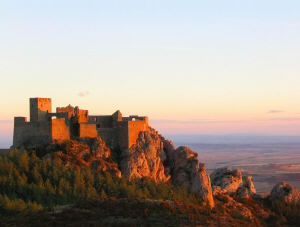 The Loarre castle was built in the early 11th century in the foothills of the Pyrenees, home to some of the best skiing spots in Spain. Unlike some of the castles on this list which were built by the Moors, this one was built to keep the advancing Moorish army out. Two of the castle’s original three towers remain, as does a chapel. The entire castle is today considered one of Spain’s finest examples of Romanesque architecture, although the church which was built in the late 11th century is of particular interest for its innovative design elements (the purpose of some of which are still debated today). Many walls and other parts of the castle have been damaged over the years, and the Loarre castle has undergone several restorations. It may not be the prettiest of Spain’s castles, but its importance cannot be overlooked.
The Loarre castle was built in the early 11th century in the foothills of the Pyrenees, home to some of the best skiing spots in Spain. Unlike some of the castles on this list which were built by the Moors, this one was built to keep the advancing Moorish army out. Two of the castle’s original three towers remain, as does a chapel. The entire castle is today considered one of Spain’s finest examples of Romanesque architecture, although the church which was built in the late 11th century is of particular interest for its innovative design elements (the purpose of some of which are still debated today). Many walls and other parts of the castle have been damaged over the years, and the Loarre castle has undergone several restorations. It may not be the prettiest of Spain’s castles, but its importance cannot be overlooked.
Alcázar of Segovia
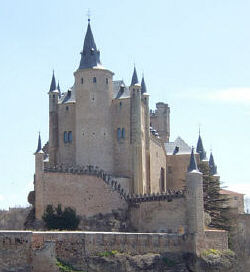 This impressively-positioned castle on the edge of a rocky cliff looks like it would be nearly impossible to attack, but one supposes that was probably the point. But however frightening El Alcázar may have looked to invaders of the past, today it’s just one of the most elegant castles in all of Spain. Located in the city of Segovia, an ideal day trip from Madrid, the castle is one of the most visited monuments in Spain. The castle dates from the 12th century, and was the site of the marriage of Ferdinand to Isabella which unified Spain in the 15th century. Some say it was one of the castles that inspired the famous Walt Disney castle, and it’s easy to see how that might be true (and even if it’s not, El Alcázar is still awfully fairy tale-ish). While the castle is a UNESCO World Heritage site today, it was actually used as a prison for nearly 200 years after the royal family moved to Madrid. It wasn’t until the late 1800s, after a fire damaged parts of the castle, that the prison was moved elsewhere and restoration began on El Alcázar to return it to its former glory. And if you’re wondering why you’re seeing an “Alcázar” advertised as a tourist attraction in places other than Segovia, that’s because the word merely means “fortress” – and there are plenty of those in Spain.
This impressively-positioned castle on the edge of a rocky cliff looks like it would be nearly impossible to attack, but one supposes that was probably the point. But however frightening El Alcázar may have looked to invaders of the past, today it’s just one of the most elegant castles in all of Spain. Located in the city of Segovia, an ideal day trip from Madrid, the castle is one of the most visited monuments in Spain. The castle dates from the 12th century, and was the site of the marriage of Ferdinand to Isabella which unified Spain in the 15th century. Some say it was one of the castles that inspired the famous Walt Disney castle, and it’s easy to see how that might be true (and even if it’s not, El Alcázar is still awfully fairy tale-ish). While the castle is a UNESCO World Heritage site today, it was actually used as a prison for nearly 200 years after the royal family moved to Madrid. It wasn’t until the late 1800s, after a fire damaged parts of the castle, that the prison was moved elsewhere and restoration began on El Alcázar to return it to its former glory. And if you’re wondering why you’re seeing an “Alcázar” advertised as a tourist attraction in places other than Segovia, that’s because the word merely means “fortress” – and there are plenty of those in Spain.
Castillo de Coca
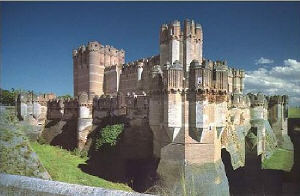 The beautiful and immense castle in Coca was built in the late 15th century by an important bishop at the time. It’s a gorgeous castle to behold, with all the stereotypical castle elements you’ve come to expect from fairy tales – there are turrets, crenelations, a big moat, and high towers. But don’t let its good looks fool you. This castle could withstand an attack just as well as the next guy. The Coca Castle foiled would-be invaders in the 1500s, and it wasn’t until the early 1800s when Napoleon’s army finally successfully took control of the castle – that was the first successful attack in the castle’s long history. Today, the Castle of Coca houses a forestry school, and so very little of the original historic interior remains. So, aside from the incredibly picturesque exterior, the other highlight of a visit to this castle is a peek at the interior courtyard, or “patio de armas,” which retains much of the original decorations. The castle is located in the Segovia region.
The beautiful and immense castle in Coca was built in the late 15th century by an important bishop at the time. It’s a gorgeous castle to behold, with all the stereotypical castle elements you’ve come to expect from fairy tales – there are turrets, crenelations, a big moat, and high towers. But don’t let its good looks fool you. This castle could withstand an attack just as well as the next guy. The Coca Castle foiled would-be invaders in the 1500s, and it wasn’t until the early 1800s when Napoleon’s army finally successfully took control of the castle – that was the first successful attack in the castle’s long history. Today, the Castle of Coca houses a forestry school, and so very little of the original historic interior remains. So, aside from the incredibly picturesque exterior, the other highlight of a visit to this castle is a peek at the interior courtyard, or “patio de armas,” which retains much of the original decorations. The castle is located in the Segovia region.
La Mota Castle
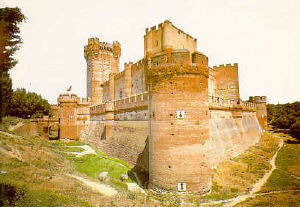 The name “La Mota” might look like it’s referring to a moat, but instead it’s actually referring to a hill upon which a castle is built – so it shouldn’t be surprising that there is more than one castle in Spain with the name “La Mota” in it somewhere. The one that’s most noteworthy among them, however, is in the town of Medina del Campo in the Valladolid province of Spain. It is one of the country’s most impressive castles, and while it may not look terribly imposing from a distance it is surrounded by an enormous moat and outer defensive wall. The La Mota Castle dates from the 12th century and was built largely by Christians, but in later centuries the complex was enhanced by Islamic artists over time so that it bears design elements from both religions and architectural styles. Even the castle’s Christian chapel feels remotely Islamic. After serving time as a prison, La Mota Castle was eventually restored in the 1930s.
The name “La Mota” might look like it’s referring to a moat, but instead it’s actually referring to a hill upon which a castle is built – so it shouldn’t be surprising that there is more than one castle in Spain with the name “La Mota” in it somewhere. The one that’s most noteworthy among them, however, is in the town of Medina del Campo in the Valladolid province of Spain. It is one of the country’s most impressive castles, and while it may not look terribly imposing from a distance it is surrounded by an enormous moat and outer defensive wall. The La Mota Castle dates from the 12th century and was built largely by Christians, but in later centuries the complex was enhanced by Islamic artists over time so that it bears design elements from both religions and architectural styles. Even the castle’s Christian chapel feels remotely Islamic. After serving time as a prison, La Mota Castle was eventually restored in the 1930s.
Castillo de Gormaz
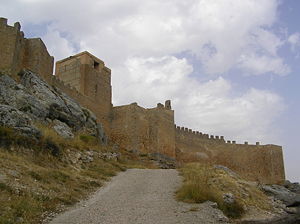 While many of the castles in Spain were at one time or another royal residences and have therefore been kept up reasonably well over time, none of them has had to last quite as long as the Castle of Gormaz. This impressive citadel dates from the 8th century, making it the oldest castle in all of Western Europe. Like the Alhambra, the Gormaz castle was also Moorish in design, and although it isn’t in nearly as good condition as the Alhambra it still has 28 of its original 31 towers. The castle, located in the Soria province of Spain, also features three Islamic prayer niches (called Mihrabs), a moat, and a giant main gate which still bears some remains of the original red and white painted designs. The Castillo de Gormaz may require you to use your imagination a bit more than some of the other castles on this list, but for sheer ability to stand the test of time (and pass with flying colors), this one deserves your attention.
While many of the castles in Spain were at one time or another royal residences and have therefore been kept up reasonably well over time, none of them has had to last quite as long as the Castle of Gormaz. This impressive citadel dates from the 8th century, making it the oldest castle in all of Western Europe. Like the Alhambra, the Gormaz castle was also Moorish in design, and although it isn’t in nearly as good condition as the Alhambra it still has 28 of its original 31 towers. The castle, located in the Soria province of Spain, also features three Islamic prayer niches (called Mihrabs), a moat, and a giant main gate which still bears some remains of the original red and white painted designs. The Castillo de Gormaz may require you to use your imagination a bit more than some of the other castles on this list, but for sheer ability to stand the test of time (and pass with flying colors), this one deserves your attention.
Alhambra
 Not only one of the best castles in Spain, the Alhambra in Granada is easily one of the Spain’s top tourist attractions – period. This castle (or, more accurately, a palace and fortress) sits atop a hill overlooking the city of Granada and was built during the mid-14th century. Part of what makes the Alhambra special is it was constructed while the area was under Muslim rule and so reflects a different architectural style than that of buildings from the same era in other parts of Spain and Europe. The name “Alhambra” is taken from an Arabic name meaning “the red fortress,” and although the complex is decidedly Moorish in its design and artwork, it wasn’t torn down after Muslim rule ended in the late 15th century. There were portions of the palace which were altered, to be sure, and Napoleon apparently wanted to blow up the entire thing (silly man), but restoration work was begun on the Alhambra as far back as the 1820s and the entire complex is now a UNESCO World Heritage Site. So even if it’s not technically a castle in the same way the rest of the structures on this list are, you’d be crazy not to mention it alongside these castles.
Not only one of the best castles in Spain, the Alhambra in Granada is easily one of the Spain’s top tourist attractions – period. This castle (or, more accurately, a palace and fortress) sits atop a hill overlooking the city of Granada and was built during the mid-14th century. Part of what makes the Alhambra special is it was constructed while the area was under Muslim rule and so reflects a different architectural style than that of buildings from the same era in other parts of Spain and Europe. The name “Alhambra” is taken from an Arabic name meaning “the red fortress,” and although the complex is decidedly Moorish in its design and artwork, it wasn’t torn down after Muslim rule ended in the late 15th century. There were portions of the palace which were altered, to be sure, and Napoleon apparently wanted to blow up the entire thing (silly man), but restoration work was begun on the Alhambra as far back as the 1820s and the entire complex is now a UNESCO World Heritage Site. So even if it’s not technically a castle in the same way the rest of the structures on this list are, you’d be crazy not to mention it alongside these castles.
For more of our top Spain travel lists: